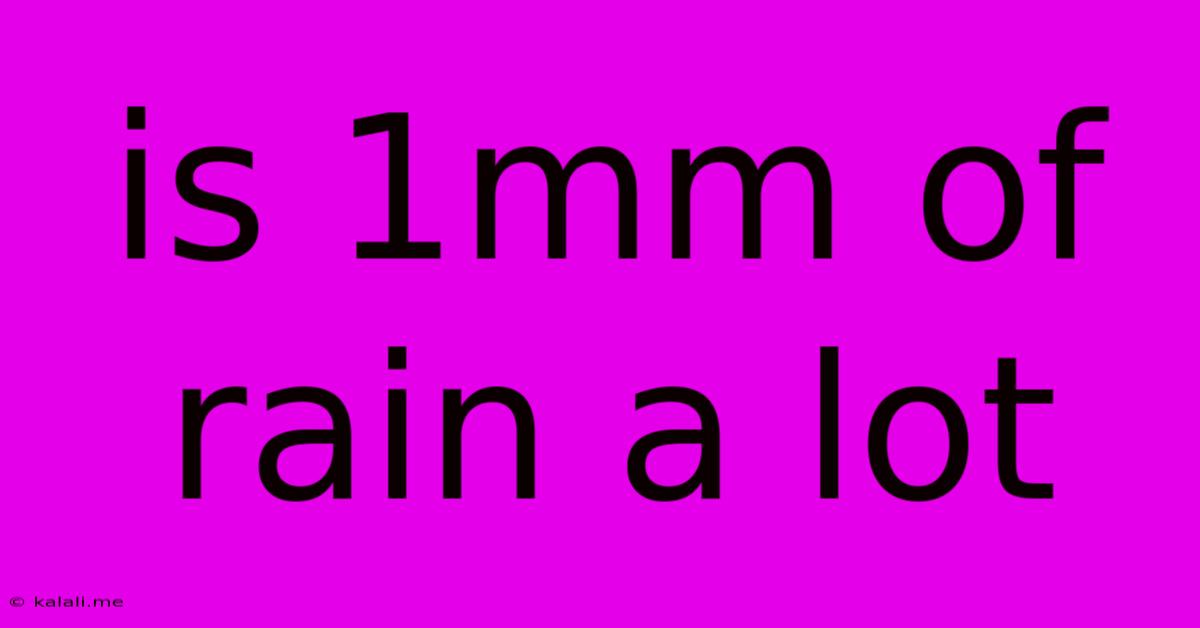Is 1mm Of Rain A Lot
Kalali
May 22, 2025 · 2 min read

Table of Contents
Is 1mm of Rain a Lot? Understanding Rainfall Measurement
Is 1mm of rain a lot? The answer isn't a simple yes or no. It depends on several factors, making it crucial to understand what 1mm of rainfall actually represents and its impact in different contexts. This article will delve into the meaning of rainfall measurement, interpret 1mm of rain in various situations, and help you understand its significance.
What does 1mm of rain mean?
Rainfall is measured in millimeters (mm), representing the depth of water that accumulates on a flat surface if all the rain that falls remains in place without running off or evaporating. Therefore, 1mm of rain means that if you had a container with perfectly vertical sides and a surface area of 1 square meter, after the rain, the water collected would be 1 millimeter deep. This might seem like a small amount, but its impact depends on the context.
Factors influencing the impact of 1mm of rainfall:
-
Geographic Location: Arid and semi-arid regions experience significantly less rainfall annually. In these areas, even 1mm of rain can be a significant contribution to soil moisture, impacting plant growth and groundwater recharge. Conversely, in regions with high annual rainfall, 1mm is a relatively small amount and may not noticeably affect the water level in rivers or lakes.
-
Time of Year: A single 1mm rainfall in a dry season can be more impactful than the same amount during a period of consistent rainfall. It could provide crucial hydration for plants stressed by drought conditions.
-
Soil Type: The type of soil plays a vital role in how much water is absorbed. Sandy soils absorb water quickly, while clay soils tend to hold water longer. Consequently, 1mm of rain might have a more pronounced effect on sandy soil than on clay soil.
-
Vegetation Cover: Areas with dense vegetation absorb more rainfall and minimize runoff compared to bare land. This can make the 1mm of rain more beneficial for the ecosystem.
1mm of rain: Significant or insignificant?
-
Insignificant: In regions with high annual rainfall, 1mm is generally insignificant, especially in terms of affecting larger water bodies or significantly altering ground water levels. It often simply replenishes surface moisture.
-
Significant: In arid regions, even 1mm of rainfall can be vital for survival and growth of vegetation. It can contribute to crucial groundwater recharge and temporarily alleviate drought conditions. For farmers relying on rainfall, this small amount might still prove beneficial.
Conclusion:
The question "Is 1mm of rain a lot?" doesn't have a universally applicable answer. Whether 1mm of rainfall is significant or not depends heavily on the local climate, soil type, vegetation, and time of year. While it might seem negligible in some areas, in others it represents a precious resource. Understanding these contextual factors allows for a more nuanced interpretation of rainfall measurements and their impact on the environment.
Latest Posts
Latest Posts
-
Is It Embarrassing To Go Back To Your Old Job
May 22, 2025
-
Where Is Chitty Bang Bang Set
May 22, 2025
-
Can You Do A Secret Santa With An Odd Number
May 22, 2025
-
Can You Put Raw Mince In The Slow Cooker
May 22, 2025
-
Footprints In The Sand Bible Verse
May 22, 2025
Related Post
Thank you for visiting our website which covers about Is 1mm Of Rain A Lot . We hope the information provided has been useful to you. Feel free to contact us if you have any questions or need further assistance. See you next time and don't miss to bookmark.